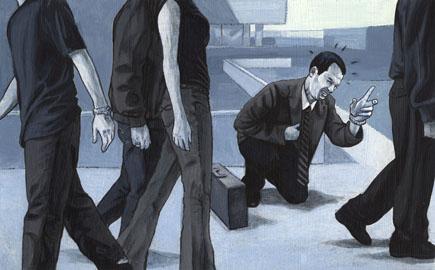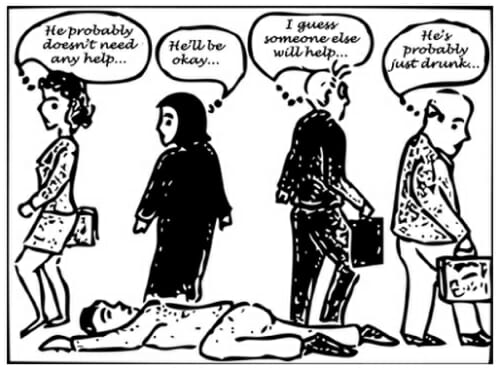By Anna Tsekani,
Genovese syndrome is always a controversial topic that raises many questions. Through the passage of time, more and more psychologies shed light upon this phenomenon and try to explain human nature and psychological patterns.
More specifically, the Genovese syndrome, also known as the bystander effect, is a social-psychological phenomenon in which people are less likely to offer assistance in an emergency when other people are present. Is a term used to describe a psychological phenomenon in which people are paralyzed instead of helping when people need their assistance in the face of danger?
This phenomenon was named after the infamous case of Kitty Genovese who was murdered in New York City in 1964 while witnesses did nothing to help her. The bystander effect emphasizes the role of social influences in shaping individual behavior in emergency situations such as responsibility diffusion and conformity.
The story of Kitty Genovese’s murder was shocking enough to garner national media attention in 1964. A stranger followed Genovese back to her New York City apartment one evening. This stranger attacked her in a stairwell that was clearly visible from other apartments. Thirty-eight of her neighbors heard her screams and saw her murder from their windows over the next half hour but none called the cops, let alone intervened. It would be nice to think that this was an isolated incident but less extreme examples occur on a daily basis.
Consider how many people never stop to assist someone on the roadside who is struggling with a flat tire. Although there are legitimate explanations for nonresponse in such situations, such as apathy, habituation, and fear of reprisal, the unifying theme appears to be the social psychological phenomenon of the bystander effect. The bystander effect basically states that when other witnesses are present, people are less likely to help in an emergency. Oftetly that does not mean that people are apathetic or afraid of retaliation but many psychologists argue that the presence of a group actively prevents an individual from acting in an emergency situation. It should be noted that the bystander effect is not a psychological mechanism in and of itself. Rather, it is a useful abbreviation for some related mechanisms. An individual who is confronted with an emergency or a situation that necessitates assistance is likely to assist.

However, when other people are present, any given individual is significantly less likely to assist. As the number of bystanders increases, the likelihood of the emergency victim receiving any assistance decreases. Four mechanisms appear to be involved in this phenomenon:
- Self-awareness: The presence of an audience to his or her actions prevents the person from acting, as people do not want to appear foolish or inappropriate in public.
- Social cues: Individuals actively seek cues from one another about how to behave in a given situation. Individual inaction is most likely caused by the inaction of others. These social cues can interact with other mechanisms to boost their effectiveness. If everyone is initially inhibited, everyone will appear inactive to the audience. Everyone will perceive everyone else as inactive, further inhibiting action.
- Blocking: When multiple bystanders intervene, the emergency situation frequently worsens. One bystander’s action effectively prevents others from acting.
- Diffuse responsibility: When only a small percentage of bystanders can intervene, responsibility is diffuse. Each person believes he or she bears only a limited amount of responsibility for the negative consequences of inaction.
Although the interactions between these four mechanisms are complex, separating them in this manner allows for the observation of significant and salient behavior in both emergency and non-emergency situations.

Such situations and incidents are influenced by similar underlying social and psychological phenomena and similarities in social behavior emerge. The bystander effect is a social behavior pattern that typically appears in situations with certain key characteristics. The consistency of behavior in various emergency situations is caused by underlying social and psychological phenomena. It is critical not to reify the bystander effect; it is an observed pattern, not a causal entity.
A well-understood pattern is a lens that can aid in the interpretation of future observations in situations that are both similar to and dissimilar to the original situation.
The bystander effect is a significant phenomenon in the field of social psychology, providing insight into how the presence of others influences individuals in emergency situations. It emphasizes the significance of investigating the role of social influences on individual behavior, such as responsibility diffusion and conformity. More research can help in order to better understand the underlying causes of the bystander effect and potentially find solutions to it. The Genovese syndrome or bystander effect may raise many questions and puzzle us, but the majority of people have been involved in an incident in which they should have mobilized but did not.
We can work toward a more supportive and responsive society by acknowledging the bystander effect.
References
-
Hudson, J. M., & Bruckman, A. S. (2004). The bystander effect: A lens for understanding patterns of participation. The Journal of the Learning Sciences, 13(2), 165-195.
-
Hall, E. J. (2003). The bystander effect. Health physics, 85(1), 31-35.
-
Rentschler, C. A. (2011). An urban physiognomy of the 1964 Kitty Genovese murder. Space and Culture, 14(3), 310-329.




